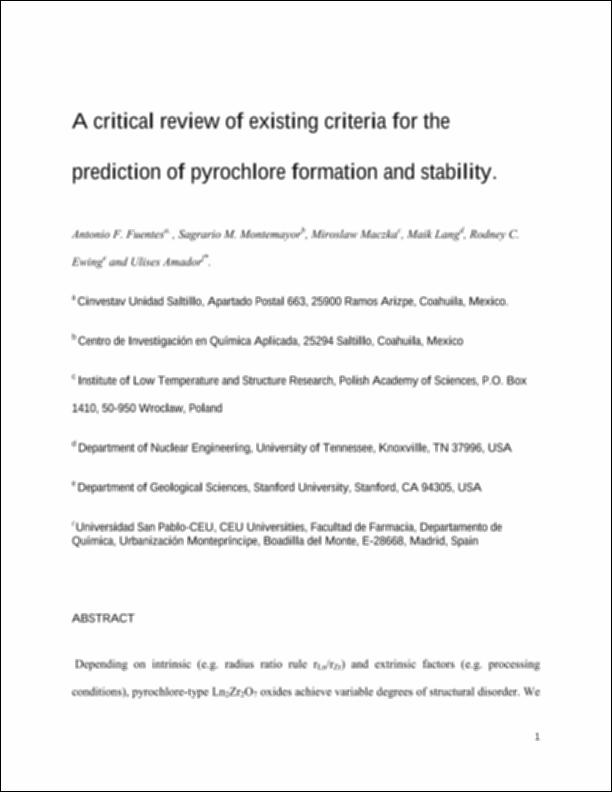Please use this identifier to cite or link to this item:
http://hdl.handle.net/10637/14816A critical review of existing criteria for the prediction of pyrochlore formation and stability.
| Title: | A critical review of existing criteria for the prediction of pyrochlore formation and stability. |
| Authors : | Fuentes, Antonio F. Montemayor, Sagrario M. Maczka, Miroslaw Lang, Maik Ewing, Rodney C. Amador Elizondo, Ulises Julio |
| Keywords: | Cations; Chemical structure; Ions; Oxides; Physical and chemical processes; Pyrochlore; Fluorite structure; Structure prediction; Mechanical milling; Raman spectroscopy |
| Publisher: | American Chemical Society |
| Citation: | Antonio F. Fuentes, Sagrario M. Montemayor, Miroslaw Maczka, Maik Lang, Rodney C. Ewing, and Ulises Amador, A Critical Review of Existing Criteria for the Prediction of Pyrochlore Formation and Stability, Inorganic Chemistry 2018 57 (19), 12093-1210 DOI: 10.1021/acs.inorgchem.8b01665 |
| Abstract: | Depending on intrinsic (e.g., radius ratio rule rLn/rZr) and extrinsic factors (e.g., processing conditions), pyrochlore-type Ln2Zr2O7 oxides achieve variable degrees of structural disorder. We report on a systematic study of the structural and microstructural characteristics of the Gd2–xLnxZr2O7 system, exploring the effect of replacing Gd with a wide range of homovalent lanthanide ions (Ln = Nd, Sm, Dy, Ho, Y, and Er; x = 0.20 and 0.80). All compositions were prepared via a mechanochemical reaction between the corresponding oxides and characterized by X-ray diffraction (standard and synchrotron sources) using the Rietveld method, as well as by Raman spectroscopy. Irrespective of chemical composition, this study reveals that all compositions exhibit a fluorite-like structure. Furthermore, by firing each sample at 800 and 1400 °C, we are able to analyze the transition to pyrochlore-like structures, featuring different degrees of disorder, in all but Gd1.20Y0.80Zr2O7, which retains the fluorite structure even after heating. The structural data are used to assess the existing criteria for predicting the formation and stability of the pyrochlore structure; according to this analysis, the simple radius ratio rule (rLn/rZr), provides a useful and sufficiently robust criterion. Because the pyrochlore structure has a strong tendency to disorder, it is not possible to define an empirical index similar to the Goldschmidt tolerance factor for perovskite. |
| URI: | http://hdl.handle.net/10637/14816 |
| Rights : | http://creativecommons.org/licenses/by-nc-nd/4.0/deed.es |
| ISSN: | 1520-510X |
| Issue Date: | 10-Sep-2018 |
| Center : | Universidad San Pablo-CEU |
| Appears in Collections: | Facultad de Farmacia |
Items in DSpace are protected by copyright, with all rights reserved, unless otherwise indicated.


